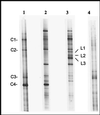Effect of phenylurea herbicides on soil microbial communities estimated by analysis of 16S rRNA gene fingerprints and community-level physiological profiles
- PMID: 10049851
- PMCID: PMC91132
- DOI: 10.1128/AEM.65.3.982-988.1999
Effect of phenylurea herbicides on soil microbial communities estimated by analysis of 16S rRNA gene fingerprints and community-level physiological profiles
Abstract
The effect of three phenyl urea herbicides (diuron, linuron, and chlorotoluron) on soil microbial communities was studied by using soil samples with a 10-year history of treatment. Denaturing gradient gel electrophoresis (DGGE) was used for the analysis of 16S rRNA genes (16S rDNA). The degree of similarity between the 16S rDNA profiles of the communities was quantified by numerically analysing the DGGE band patterns. Similarity dendrograms showed that the microbial community structures of the herbicide-treated and nontreated soils were significantly different. Moreover, the bacterial diversity seemed to decrease in soils treated with urea herbicides, and sequence determination of several DGGE fragments showed that the most affected species in the soils treated with diuron and linuron belonged to an uncultivated bacterial group. As well as the 16S rDNA fingerprints, the substrate utilization patterns of the microbial communities were compared. Principal-component analysis performed on BIOLOG data showed that the functional abilities of the soil microbial communities were altered by the application of the herbicides. In addition, enrichment cultures of the different soils in medium with the urea herbicides as the sole carbon and nitrogen source showed that there was no difference between treated and nontreated soil in the rate of transformation of diuron and chlorotoluron but that there was a strong difference in the case of linuron. In the enrichment cultures with linuron-treated soil, linuron disappeared completely after 1 week whereas no significant transformation was observed in cultures inoculated with nontreated soil even after 4 weeks. In conclusion, this study showed that both the structure and metabolic potential of soil microbial communities were clearly affected by a long-term application of urea herbicides.
Figures







Similar articles
-
Enrichment and molecular characterization of a bacterial culture that degrades methoxy-methyl urea herbicides and their aniline derivatives.Appl Environ Microbiol. 2000 Dec;66(12):5110-5. doi: 10.1128/AEM.66.12.5110-5115.2000. Appl Environ Microbiol. 2000. PMID: 11097876 Free PMC article.
-
Do conventionally and biologically cultivated soils differ in bacterial diversity and community structure?Meded Rijksuniv Gent Fak Landbouwkd Toegep Biol Wet. 2001;66(3b):381-8. Meded Rijksuniv Gent Fak Landbouwkd Toegep Biol Wet. 2001. PMID: 15954622
-
Metabolites of the phenylurea herbicides chlorotoluron, diuron, isoproturon and linuron produced by the soil fungus Mortierella sp.Environ Pollut. 2009 Oct;157(10):2806-12. doi: 10.1016/j.envpol.2009.04.019. Epub 2009 May 22. Environ Pollut. 2009. PMID: 19464778
-
Effect of pesticides on soil microbial community.J Environ Sci Health B. 2010 Jul;45(5):348-59. doi: 10.1080/10934520903467873. J Environ Sci Health B. 2010. PMID: 20512724 Review.
-
Advances in monitoring soil microbial community dynamic and function.J Appl Genet. 2020 May;61(2):249-263. doi: 10.1007/s13353-020-00549-5. Epub 2020 Feb 15. J Appl Genet. 2020. PMID: 32062778 Review.
Cited by
-
Microbial community dynamics during the bioremediation process of chlorimuron-ethyl-contaminated soil by Hansschlegelia sp. strain CHL1.PLoS One. 2015 Feb 17;10(2):e0117943. doi: 10.1371/journal.pone.0117943. eCollection 2015. PLoS One. 2015. PMID: 25689050 Free PMC article.
-
Poly(A) polymerase modification and reverse transcriptase PCR amplification of environmental RNA.Appl Environ Microbiol. 2005 Mar;71(3):1267-75. doi: 10.1128/AEM.71.3.1267-1275.2005. Appl Environ Microbiol. 2005. PMID: 15746328 Free PMC article.
-
Design and evaluation of PCR primers for analysis of bacterial populations in wine by denaturing gradient gel electrophoresis.Appl Environ Microbiol. 2003 Nov;69(11):6801-7. doi: 10.1128/AEM.69.11.6801-6807.2003. Appl Environ Microbiol. 2003. PMID: 14602643 Free PMC article.
-
Degradation of Diuron by a Bacterial Mixture and Shifts in the Bacterial Community During Bioremediation of Contaminated Soil.Curr Microbiol. 2021 Dec 14;79(1):11. doi: 10.1007/s00284-021-02685-5. Curr Microbiol. 2021. PMID: 34905076
-
Persistent Hg contamination and occurrence of Hg-methylating transcript (hgcA) downstream of a chlor-alkali plant in the Olt River (Romania).Environ Sci Pollut Res Int. 2016 Jun;23(11):10529-10541. doi: 10.1007/s11356-015-5906-4. Epub 2015 Dec 11. Environ Sci Pollut Res Int. 2016. PMID: 26662302
References
-
- Allison N, Turner J E, Wait R. Degradation of homovanillate by a strain of Variovorax paradoxus via ring hydroxylation. FEMS Microbiol Lett. 1995;134:213–219. - PubMed
-
- Bromilow R H, Evans A A, Nicholls P H, Todd A D, Briggs G G. The effect on soil fertility of repeated applications of pesticides over 20 years. Pestic Sci. 1996;48:63–72.
-
- Caux P Y, Kent R A, Fan G T, Grande C. Canadian water quality guidelines for linuron. Environ Toxicol Water Qual. 1998;13:1–41.
Publication types
MeSH terms
Substances
Associated data
- Actions
- Actions
- Actions
LinkOut - more resources
Full Text Sources
Other Literature Sources
Molecular Biology Databases
Research Materials

